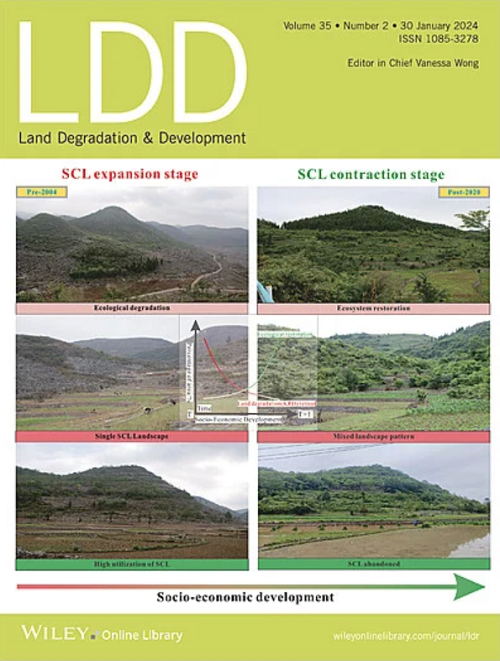Afforestation With Xerophytic Shrubs Promoted Soil Organic Carbon Stability in a Hyper‐Arid Environment of Desert
IF 3.6
2区 农林科学
Q2 ENVIRONMENTAL SCIENCES
引用次数: 0
Abstract
In desert ecosystems, afforestation with xerophytic shrubs has the potential to significantly increase soil nutrient levels by mitigating wind and soil erosion. Nevertheless, further investigation is required to elucidate the changes in soil organic carbon (SOC) fractions and stability on different soil depths with afforestation years. We collected soil samples from the 0–20, 20–60, and 60–100 cm depths of three xerophytic shrublands ages (3, 7, and 10 years), with a natural desert as the control, in a hyper‐arid desert region. We investigated the variations of SOC fractions (stable and active C) and stability (stability index and MAOC:POC ratios) after afforestation. The results showed that the rate of increase in SOC fractions and stability did not follow a linear trajectory with afforestation years. Instead, they accelerated around 7 years but then decreased after 10 years. The increase in SOC stability was primarily attributed to the greater increase in stable C within the total SOC pool. Afforestation increased the concentration of ROC from 0.26 to 0.89 g kg利用旱生灌木造林促进沙漠高干旱环境中土壤有机碳的稳定性
在沙漠生态系统中,利用旱生灌木植树造林有可能减轻风蚀和土壤侵蚀,从而显著提高土壤养分水平。尽管如此,我们仍需进一步研究不同土壤深度的土壤有机碳(SOC)组分和稳定性随造林年限的变化。我们在极度干旱的沙漠地区,以自然沙漠为对照,采集了三个不同树龄(3 年、7 年和 10 年)的旱生灌木林 0-20、20-60 和 60-100 厘米深度的土壤样本。我们研究了植树造林后 SOC 分量(稳定 C 和活性 C)和稳定性(稳定指数和 MAOC:POC 比率)的变化。结果表明,SOC 分量和稳定性的增加速度并没有随着植树造林年限的增加而呈现线性轨迹。相反,它们在 7 年左右加速上升,但在 10 年后下降。SOC 稳定性的增加主要归因于总 SOC 池中稳定 C 的增加。植树造林使 ROC 浓度从 0.26 克/千克增加到 0.89 克/千克,MAOC 浓度从 0.11 克/千克增加到 0.78 克/千克。与 0-100 厘米的 CK 相比,植树造林使 SOC 的稳定性提高了 74.36%-231% 。60-100 厘米土层的 SOC 稳定性高于 0-20 厘米土层,而不同土层的 SOC 稳定性差异不大。对 SOC 稳定性产生最直接积极影响的是土壤理化性质的变化,而不是土壤微生物生物量或聚合稳定性。这些发现有助于我们理解植树造林对提高荒漠生态系统中 SOC 稳定性的重要性。
本文章由计算机程序翻译,如有差异,请以英文原文为准。
求助全文
约1分钟内获得全文
求助全文
来源期刊

Land Degradation & Development
农林科学-环境科学
CiteScore
7.70
自引率
8.50%
发文量
379
审稿时长
5.5 months
期刊介绍:
Land Degradation & Development is an international journal which seeks to promote rational study of the recognition, monitoring, control and rehabilitation of degradation in terrestrial environments. The journal focuses on:
- what land degradation is;
- what causes land degradation;
- the impacts of land degradation
- the scale of land degradation;
- the history, current status or future trends of land degradation;
- avoidance, mitigation and control of land degradation;
- remedial actions to rehabilitate or restore degraded land;
- sustainable land management.
 求助内容:
求助内容: 应助结果提醒方式:
应助结果提醒方式:


